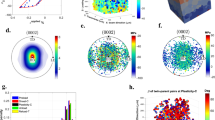Conclusions
-
1.
Statistical distribution of twin orientations was determined on coarsely granular (dav=1.7 mm) iron tube specimens subjected to five forms of loading in a plane stress state at subzero temperatures. In general the grouping of twin orientations corresponded to the theoretically predicted oreintation of traces produced by planes of the action of the maximum shear stress intersecting the specimen surface. The only exception were the results of tests on specimens strained in nonuniform biaxial tension (K=+0.667). The results as a whole prove that macroscopic shear stresses play a decisive part in the nucleation and growth of twins in polycrystals.
-
2.
The deformation due to twinning constituted a negligible part of the total deformation of specimens at rupture and was not markedly dependent on temperature or stress state conditions. It appears that, regardless of temperature and stress state (in the ranges of those parameters studies), the process of twinning starts and ends in a narrow stress range.
-
3.
The position of the sites of microcrack nucleation and the differences in the way in which twins and microcracks depend on temperature and stress state conditions made it possible to conclude that twins cannot be regarded as the main cause of the nucleation of cleavage in coarsely crystalline iron at temperatures ranging from +20 to −175°C.
-
4.
No evidence of any substantial dependence of the twin density on stress state conditions was observed at any of the test temperatures use. Since the formation of a twin depends on a certain critical stress τcr being reached, it may be concluded that the spherical tensor in the range investigated (τcr 5.16 ⋄ σ0⋄ τσ/0.75) has no significant influence on the twinning phenomena; at the same time it plays an important part in the opening of microcracks formed as a result of plastic deformation of iron.
Similar content being viewed by others
Literature Cited
N. N. Davidenkov, Dokl. Akad. Nauk SSSR (1937).
E. M. Shevandin, Zh. Tekh. Fiz.,8, No. 441 (1938).
R. I. Garber, I. A. Gindin, and M. G. Konstantinovskii, Zh. Tekh. Fiz.,23, No. 12 (1953).
V. V. Sashkov and Ya. M. Potak, Zh. Eksperim. Teor. Fiz.,24, No. 3 (1954).
D. Hall, in: Fracture of Solids [Russian translation], Metallurgiya, Moscow (1967).
V. M. Finkel', Fracture Physics [in Russian], Metallurgiya, Moscow (1970).
R. I. Garber, Zh. Tekh. Fiz.,17, No. 47 (1947).
I. V. Obreimov and V. I. Startsev, Zh. Eksperim. Teor. Fiz.,35, No. 5 (11) (1958).
M. V. Klassen-Neklyudova, Mechanical Twinning of Crystals [in Russian], Izd. AN SSSR, Moscow (1960).
V. P. Soldatov and V. I. Startsev, Fiz. Tverd. Tela,12, No. 1 (1970).
C. N. Reid and A. Gilbert, Journ. Less Common. Met.,10, No. 2 (1966).
V. F. Moiseev and V. I. Trefilov, in: Physical Nature of Plastic Deformation and Fracture of Metals, No. 21, Metal Physics [in Russian], Naukova Dumka, Kiev (1969).
A. M. Kosevich and V. S. Boiko, Usp. Fiz. Nauk,104, No. 2 (1971).
A. C. Cotrell, in: Atomic Mechanism of Fracture [Russian translation], Metallurgizdat, Moscow (1963).
C. J. McMahon, Jr. and M. Cohen, Acta Met.,13, No. 6 (1965).
G. T. Hahn, B. L. Averbach, et al., in: Atomic Mechanism of Fracture [Russian translation], Metallurgizdat, Moscow (1963).
A. A. Lebedev and F. F. Giginyak, in: Heat Resistance of Materials and Structural Elements [in Russian], No. 5, Naukova Dumka, Kiev (1969).
F. F. Giginyak, A. A. Lebedev, and A.Ya. Krasovskii, Metall. i. Term. Obrabotka, No. 4 (1970).
Additional information
Institute of the Strength of Materials, Academy of Sciences of the Ukrainian SSR, Kiev. Translated from Problemy Prochnosti, No. 12, pp. 30–39, December 1972.
Rights and permissions
About this article
Cite this article
Krasovskii, A.Y., Makovetskaya, I.A., Lebedev, A.A. et al. Twinning in iron at low temperatures under plane stress state conditions. Strength Mater 4, 1448–1456 (1972). https://doi.org/10.1007/BF01530113
Received:
Issue Date:
DOI: https://doi.org/10.1007/BF01530113




